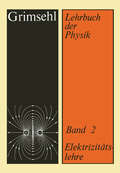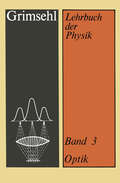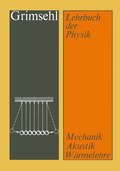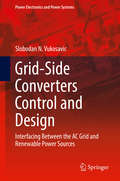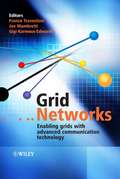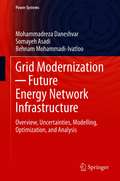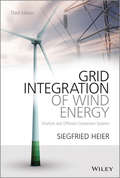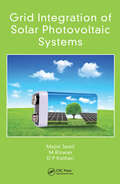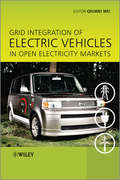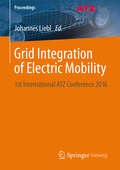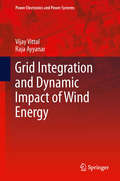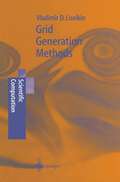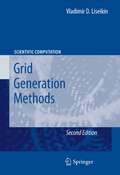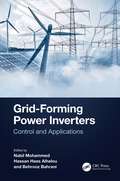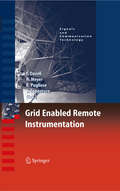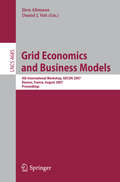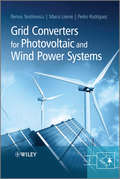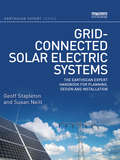- Table View
- List View
Grimlock's Bad Friend: Book 3 (Transformers Early Reader #2)
by TransformersA full-colour early reader based on the hugely popular Transformers TV series.Grimlock is very excited when he meets another Dinobot just like him. But Scowl is very naughty - and he wants Grimlock to be bad too! Will Grimlock learn not to follow his bad friend?This early reader is specially created with a literacy consultant and is perfect to build reading ability. Now even the youngest Transformers fans can read along with their adventures!
Grilled: Turning Adversaries into Allies to Change the Chicken Industry
by Leah Garcés'An animal activist's journey to the "other side"' Joanna LumleyThis is the story of what happens when we cross enemy lines to look for solutions.Leah Garcés has dedicated her career to fighting for the rights of the animals that end up on our plates. As President of the non-profit group Mercy for Animals and former US Executive Director of Compassion in World Farming, she has led the fight against the sprawling chicken industry that raises billions of birds in cruel conditions – all to satisfy our appetite for meat.Grilled is Leah's story of working alongside the food and farming industry for animal welfare and ethical food. Instead of fighting and protesting and shaming – approaches that simply haven't worked previously – Garcés has instead tried to find common ground with producers. She has worked alongside owners of the megafarms, befriending them, having frank conversations with them, and ultimately encouraging change through dialogue and discussion. Leah is helping to directly improve the lives of millions of farm animals, and pushing alternatives such as plant-based substitutes and lab-grown meats to the top of the agenda, with some of the mega-farm conglomerates joining forces with her to explore these avenues.When she started her journey, Leah Garcés did not have much empathy to spare for the contract chicken farmer –until she actually met one and tried to understand the difficulties they faced. This is the story of giving in to discomfort for the sake of progress. It's a story of the power of human connection, and what happens when we practice empathy toward our enemies.
Grid-Side Converters Control and Design: Interfacing Between the AC Grid and Renewable Power Sources (Power Electronics and Power Systems)
by Slobodan N. VukosavicThis textbook is intended for engineering students taking courses in power electronics, renewable energy sources, smart grids or static power converters. It is also appropriate for students preparing a capstone project where they need to understand, model, supply, control and specify the grid side power converters. The main goal of the book is developing in students the skills that are required to design, control and use static power converters that serve as an interface between the ac grid and renewable power sources. The same skills can be used to design, control and use the static power converters used within the micro-grids and nano-grids, as the converters that provide the interface between such grids and the external grid. The author’s approach starts with basic functionality and the role of grid connected power converters in their typical applications, and their static and dynamic characteristics. Particular effort is dedicated to developing simple, concise, intuitive and easy-to-use mathematical models that summarize the essence of the grid side converter dynamics. Mathematics is reduced to a necessary minimum, solved examples are used extensively to introduce new concepts, and exercises are used to test mastery of new skills.
Grid Networks: Enabling Grids with Advanced Communication Technology
by Franco Travostino Joe Mambretti Gigi Karmous-EdwardsA book that bridges the gap between the communities of network and Grid experts. Grid Networks describes the convergence of advanced networking technologies and Grid technologies, with special focus on their symbiotic relationship and the resulting new opportunities. Grid technology is applicable to many implementations, Computational Grids, Data Grids, Service Grids, and Instrumentation Grids. The authors cover a breadth of topics including recent research, featuring both theoretical concepts and empirical results. Beginning with an overview of Grid technologies, an analysis of distinguishing use cases and architectural attributes, and emerging standards. Travostino et al. discuss new directions in multiple networking technologies that are enabling enhanced capabilities for Grids. An appendix also provides an overview of experimental research test-beds and prototype implementations. These topics will enable network experts to design networks to best match Grid requirements, while Grid experts will learn how to effectively utilize network resources. Grid Networks: Enabling Grids with Advanced Communication Technology: Bridges the gap between the communities of network and Grid experts. Covers new network requirements posed by the Grid, and the paradigm shifts prompted by Grid applications. Discusses basic architectural concepts and directions related to the integration of Grid and networking technologies, especially those that elevate network resources to first class entities within Grid environments. Details new directions in networking technologies for the Grid, including Network Infrastructure & Management, Service Provisioning, High Performance Data Transport, Performance Monitoring, Reliability, and Network-Assisted Service Frameworks. Provides an overview of advanced research testbeds and innovative early implementations of emerging architecture and technology. Many communities will find this book an invaluable resource, including engineers and product managers, research scientists within academia, industry, and government agencies, advanced students and faculty in distributed systems courses, network and systems architects, CIOs, administrators of advanced networks, application developers, and providers of next generation distributed services.
Grid Modernization ─ Future Energy Network Infrastructure: Overview, Uncertainties, Modelling, Optimization, and Analysis (Power Systems)
by Mohammadreza Daneshvar Somayeh Asadi Behnam Mohammadi-IvatlooThis book presents theoretical, technical, and practical information on the modernization of future energy networks. All the basic requirements covering concepts, modeling, optimizing, and analyzing of future energy grids with various energy carriers such as electricity, gas, heat, and water, as well as their markets and contracts, are explained in detail. The main focus of the book is on modernizing both the energy consumers and the energy producers and analyzing various aspects of grid modernization such as reliability, resiliency, stability, and security. Coverage includes advanced communication protocols and solution methods for the Internet of Energy (IoE) infrastructure and energy trading in future energy grids with high/full share of renewable energy resources (RERs) within the transactive energy (TE) paradigm. Probabilistic modeling and optimizing of modern grids will be evaluated using realistic case studies considering the economic aspects of multi-carrier energy markets. This book will be welcomed as an important resource by researchers and postgraduate students studying energy systems, as well as practicing engineers working on modernizing energy grids and the design, planning, scheduling, and operation of smart power systems.Proposes practical solutions for solving the challenges of modern multi-carrier energy grids;Examines various types of energy storage systems and distributed energy resources (DERs) with an emphasis on renewable energy resources (RERs);Provides comprehensive mathematical models for optimizing of future modern multi-carrier energy grids.
Grid Integration of Wind Energy: Onshore and Offshore Conversion Systems
by Siegfried HeierThis popular reference describes the integration of wind-generated power into electrical power systems and, with the use of advanced control systems, illustrates how wind farms can be made to operate like conventional power plants. Fully revised, the third edition provides up-to-date coverage on new generator developments for wind turbines, recent technical developments in electrical power conversion systems, control design and essential operating conditions. With expanded coverage of offshore technologies, this edition looks at the characteristics and static and dynamic behaviour of offshore wind farms and their connection to the mainland grid. Brand new material includes: comprehensive treatment of onshore and offshore grid integration updated legislative guidelines for the design, construction and installation of wind power plants the fundamental characteristics and theoretical tools of electrical and mechanical components and their interactions new and future types of generators, converters, power electronics and controller designs improved use of grid capacities and grid support for fixed- and variable-speed controlled wind power plants options for grid control and power reserve provision in wind power plants and wind farms This resource is an excellent guide for researchers and practitioners involved in the planning, installation and grid integration of wind turbines and power plants. It is also highly beneficial to university students studying wind power technology, renewable energy and power systems, and to practitioners in wind engineering, turbine design and manufacture and electrical power engineering.
Grid Integration of Wind Energy: Onshore and Offshore Conversion Systems
by Siegfried HeierThis popular reference describes the integration of wind-generated power into electrical power systems and, with the use of advanced control systems, illustrates how wind farms can be made to operate like conventional power plants. Fully revised, the third edition provides up-to-date coverage on new generator developments for wind turbines, recent technical developments in electrical power conversion systems, control design and essential operating conditions. With expanded coverage of offshore technologies, this edition looks at the characteristics and static and dynamic behaviour of offshore wind farms and their connection to the mainland grid. Brand new material includes: comprehensive treatment of onshore and offshore grid integration updated legislative guidelines for the design, construction and installation of wind power plants the fundamental characteristics and theoretical tools of electrical and mechanical components and their interactions new and future types of generators, converters, power electronics and controller designs improved use of grid capacities and grid support for fixed- and variable-speed controlled wind power plants options for grid control and power reserve provision in wind power plants and wind farms This resource is an excellent guide for researchers and practitioners involved in the planning, installation and grid integration of wind turbines and power plants. It is also highly beneficial to university students studying wind power technology, renewable energy and power systems, and to practitioners in wind engineering, turbine design and manufacture and electrical power engineering.
Grid Integration of Solar Photovoltaic Systems
by Majid Jamil M Rizwan D P KothariThis book covers the various aspects of solar photovoltaic systems including measurement of solar irradiance, solar photovoltaic modules, arrays with MATLAB implementation, recent MPPT techniques, latest literature of converter design (with MATLAB Simulink models), energy storage for PV applications, balance of systems, grid integration of PV systems, PV system protection, economics of grid connected PV system and system yield performance using PV system. Challenges, issues and solutions related to grid integration of solar photovoltaic systems are also be dealt with.
Grid Integration of Solar Photovoltaic Systems
by Majid Jamil M Rizwan D P KothariThis book covers the various aspects of solar photovoltaic systems including measurement of solar irradiance, solar photovoltaic modules, arrays with MATLAB implementation, recent MPPT techniques, latest literature of converter design (with MATLAB Simulink models), energy storage for PV applications, balance of systems, grid integration of PV systems, PV system protection, economics of grid connected PV system and system yield performance using PV system. Challenges, issues and solutions related to grid integration of solar photovoltaic systems are also be dealt with.
Grid Integration of Electric Vehicles in Open Electricity Markets
by Qiuwei WuPresenting the policy drivers, benefits and challenges for grid integration of electric vehicles (EVs) in the open electricity market environment, this book provides a comprehensive overview of existing electricity markets and demonstrates how EVs are integrated into these different markets and power systems. Unlike other texts, this book analyses EV integration in parallel with electricity market design, showing the interaction between EVs and differing electricity markets. Future regulating power market and distribution system operator (DSO) market design is covered, with up-to-date case studies and examples to help readers carry out similar projects across the world. With in-depth analysis, this book describes: the impact of EV charging and discharging on transmission and distribution networks market-driven EV congestion management techniques, for example the day-ahead tariff based congestion management scenario within electric distribution networks optimal EV charging management with the fleet operator concept and smart charging management EV battery technology, modelling and tests the use of EVs for balancing power fluctuations from renewable energy sources, looking at power system operation support, including frequency reserve, power regulation and voltage support An accessible technical book for power engineers and grid/distributed systems operators, this also serves as a reference text for researchers in the area of EVs and power systems. It provides distribution companies with the knowledge they need when facing the challenges introduced by large scale EV deployment, and demonstrates how transmission system operators (TSOs) can develop the existing system service market in order to fully utilize the potential of EV flexibility. With thorough coverage of the technologies for EV integration, this volume is informative for research professors and graduate students in power systems; it will also appeal to EV manufacturers, regulators, EV market professionals, energy providers and traders, mobility providers, EV charging station companies, and policy makers.
Grid Integration of Electric Vehicles in Open Electricity Markets
by Qiuwei WuPresenting the policy drivers, benefits and challenges for grid integration of electric vehicles (EVs) in the open electricity market environment, this book provides a comprehensive overview of existing electricity markets and demonstrates how EVs are integrated into these different markets and power systems. Unlike other texts, this book analyses EV integration in parallel with electricity market design, showing the interaction between EVs and differing electricity markets. Future regulating power market and distribution system operator (DSO) market design is covered, with up-to-date case studies and examples to help readers carry out similar projects across the world. With in-depth analysis, this book describes: the impact of EV charging and discharging on transmission and distribution networks market-driven EV congestion management techniques, for example the day-ahead tariff based congestion management scenario within electric distribution networks optimal EV charging management with the fleet operator concept and smart charging management EV battery technology, modelling and tests the use of EVs for balancing power fluctuations from renewable energy sources, looking at power system operation support, including frequency reserve, power regulation and voltage support An accessible technical book for power engineers and grid/distributed systems operators, this also serves as a reference text for researchers in the area of EVs and power systems. It provides distribution companies with the knowledge they need when facing the challenges introduced by large scale EV deployment, and demonstrates how transmission system operators (TSOs) can develop the existing system service market in order to fully utilize the potential of EV flexibility. With thorough coverage of the technologies for EV integration, this volume is informative for research professors and graduate students in power systems; it will also appeal to EV manufacturers, regulators, EV market professionals, energy providers and traders, mobility providers, EV charging station companies, and policy makers.
Grid Integration of Electric Mobility: 1st International ATZ Conference 2016 (Proceedings)
by Johannes LieblThe UN Climate Change Conference in Paris, with its key topics of global warming and deteriorating air quality, will speed up the advance of electric mobility. CO2-neutral and zero-emission mobility require electricity to be generated from regenerative sources of energy. Power generation from wind and solar energy, however is dependent on the weather and is therefore not stable. The irregularities that occur in nature can result in unacceptable voltage fluctuations in the power grid. For that reason, the availability of highly flexible loads and storage systems is becoming particularly important. Electric vehicles, with their grid-relevant properties as controllable power consumers and electricity storage systems, could help to stabilize future power grids.
Grid Integration and Dynamic Impact of Wind Energy (Power Electronics and Power Systems)
by Vijay Vittal Raja AyyanarGrid Integration and Dynamic Impact of Wind Energy details the integration of wind energy resources to the electric grid worldwide. Authors Vijay Vittal and Raja Ayyanar include detailed coverage of the power converters and control used in interfacing electric machines and power converters used in wind generators, and extensive descriptions of power systems operation and control to accommodate large penetration of wind resources.Key concepts will be illustrated through extensive power electronics and power systems simulations using software like MATLAB, Simulink and PLECS. The book addresses real world problems and solutions in the area of grid integration of wind resources, and will be a valuable resource for engineers and researchers working in renewable energy and power.
Grid Generation Methods (Scientific Computation)
by Vladimir D. LiseikinThis text is an introduction to methods of grid generation technology in scientific computing. Special attention is given to methods developed by the author for the treatment of singularly-perturbed equations, e.g. in modeling high Reynolds number flows. Functionals of conformality, orthogonality, energy and alignment are discussed.
Grid Generation Methods (Scientific Computation)
by Vladimir D. LiseikinThis text is an introduction to methods of grid generation technology in scientific computing. Special attention is given to methods developed by the author for the treatment of singularly-perturbed equations, e.g. in modeling high Reynolds number flows. Functionals of conformality, orthogonality, energy and alignment are discussed.
Grid-Forming Power Inverters: Control and Applications
by Nabil Mohammed Hassan Haes Alhelou Behrooz BahraniGrid-Forming Power Inverters: Control and Applications is the first book dedicated to addressing the operation principles, grid codes, modelling and control of grid-forming power inverters. The book initially discusses the need for this technology due to the substantial annual integration of inverter-based renewable energy resources. The key differences between the traditional grid-following and the emerging grid-forming inverters technologies are explained. Then, the book explores in detail various topics related to grid-forming power inverters, including requirements and grid standards, modelling, control, damping power system oscillations, dynamic stability under large fault events, virtual oscillator-controlled grid-forming inverters, grid-forming inverters interfacing battery energy storage, and islanded operation of grid-forming inverters. Features: Explains the key differences between grid-following and grid-forming inverters Explores the requirements and grid standards for grid-forming inverters Provides detailed modeming of virtual synchronous generators Explains various control strategies for grid-forming inverters Investigates damping of power system oscillations using grid-forming converters Elaborates on the dynamic stability of grid-forming inverters under large fault events Focuses on practical applications
Grid-Forming Power Inverters: Control and Applications
by Nabil Mohammed Hassan Haes Alhelou Behrooz BahraniGrid-Forming Power Inverters: Control and Applications is the first book dedicated to addressing the operation principles, grid codes, modelling and control of grid-forming power inverters. The book initially discusses the need for this technology due to the substantial annual integration of inverter-based renewable energy resources. The key differences between the traditional grid-following and the emerging grid-forming inverters technologies are explained. Then, the book explores in detail various topics related to grid-forming power inverters, including requirements and grid standards, modelling, control, damping power system oscillations, dynamic stability under large fault events, virtual oscillator-controlled grid-forming inverters, grid-forming inverters interfacing battery energy storage, and islanded operation of grid-forming inverters. Features: Explains the key differences between grid-following and grid-forming inverters Explores the requirements and grid standards for grid-forming inverters Provides detailed modeming of virtual synchronous generators Explains various control strategies for grid-forming inverters Investigates damping of power system oscillations using grid-forming converters Elaborates on the dynamic stability of grid-forming inverters under large fault events Focuses on practical applications
Grid Enabled Remote Instrumentation (Signals and Communication Technology)
by Franco Davoli Norbert Meyer Roberto Pugliese Sandro ZappatoreGrid architectures, which are viewed as tools for the integration of distributed resources, play a significant role as managers of computational resources, but also as aggregators of measurement instrumentation and pervasive large-scale data acquisition platforms. The functionality of a grid architecture allows managing, maintaining, and exploiting hetereogeneous instrumentation and acquisition devices in a unifed way by providing standardized interfaces and common work environments to their users. This result is achieved through the properties of isolation from the physical network and from the peculiarites of the instrumentation granted by standard middleware together with secure and flexibile mechanisms which seek, access, and aggregate distributed resources. This book focuses on a number of aspects related to the effective exploitation of remote instrumentation on the grid. These include middleware architecture, high speed networking in support of grid applications, wireless grid for acquisition devices and sensor networks, quality of service provisioning for real time control, and measurement instrumentation.
Grid Economics and Business Models: 4th International Workshop, GECON 2007, Rennes, France, August 28, 2007, Proceedings (Lecture Notes in Computer Science #4685)
by Daniel J. VeitThis volume constitutes the refereed proceedings of the 4th International Workshop on Grid Economics and Business Models held in August 2007. The twelve full papers are organized into topical sections covering grid business modeling, market mechanisms for the grid, and economic grid service provisioning. The proceedings are rounded off by six project reports that give an overview of current and ongoing research in grid economics.
Grid Converters for Photovoltaic and Wind Power Systems (Wiley - IEEE #29)
by Remus Teodorescu Marco Liserre Pedro RodriguezGrid converters are the key player in renewable energy integration. The high penetration of renewable energy systems is calling for new more stringent grid requirements. As a consequence, the grid converters should be able to exhibit advanced functions like: dynamic control of active and reactive power, operation within a wide range of voltage and frequency, voltage ride-through capability, reactive current injection during faults, grid services support. This book explains the topologies, modulation and control of grid converters for both photovoltaic and wind power applications. In addition to power electronics, this book focuses on the specific applications in photovoltaic wind power systems where grid condition is an essential factor. With a review of the most recent grid requirements for photovoltaic and wind power systems, the book discusses these other relevant issues: modern grid inverter topologies for photovoltaic and wind turbines islanding detection methods for photovoltaic systems synchronization techniques based on second order generalized integrators (SOGI) advanced synchronization techniques with robust operation under grid unbalance condition grid filter design and active damping techniques power control under grid fault conditions, considering both positive and negative sequences Grid Converters for Photovoltaic and Wind Power Systems is intended as a coursebook for graduated students with a background in electrical engineering and also for professionals in the evolving renewable energy industry. For people from academia interested in adopting the course, a set of slides is available for download from the website. www.wiley.com/go/grid_converters
Grid Converters for Photovoltaic and Wind Power Systems (Wiley - IEEE #16)
by Remus Teodorescu Marco Liserre Pedro RodriguezGrid converters are the key player in renewable energy integration. The high penetration of renewable energy systems is calling for new more stringent grid requirements. As a consequence, the grid converters should be able to exhibit advanced functions like: dynamic control of active and reactive power, operation within a wide range of voltage and frequency, voltage ride-through capability, reactive current injection during faults, grid services support. This book explains the topologies, modulation and control of grid converters for both photovoltaic and wind power applications. In addition to power electronics, this book focuses on the specific applications in photovoltaic wind power systems where grid condition is an essential factor. With a review of the most recent grid requirements for photovoltaic and wind power systems, the book discusses these other relevant issues: modern grid inverter topologies for photovoltaic and wind turbines islanding detection methods for photovoltaic systems synchronization techniques based on second order generalized integrators (SOGI) advanced synchronization techniques with robust operation under grid unbalance condition grid filter design and active damping techniques power control under grid fault conditions, considering both positive and negative sequences Grid Converters for Photovoltaic and Wind Power Systems is intended as a coursebook for graduated students with a background in electrical engineering and also for professionals in the evolving renewable energy industry. For people from academia interested in adopting the course, a set of slides is available for download from the website. www.wiley.com/go/grid_converters
Grid-connected Solar Electric Systems: The Earthscan Expert Handbook for Planning, Design and Installation (Earthscan Expert)
by Geoff Stapleton Susan NeillSolar electricity – or photovoltaics (PV) – is the world's fastest growing energy technology. It can be used on a wide variety of scales, from single dwellings to utility-scale solar farms providing power for whole communities. It can be integrated into existing electricity grids with relative simplicity, meaning that in times of low solar energy users can continue to draw power from the grid, while power can be fed or sold back into the grid at a profit when their electricity generation exceeds the amount they are using. The falling price of the equipment combined with various incentive schemes around the world have made PV into a lucrative low carbon investment, and as such demand has never been higher for the technology, and for people with the expertise to design and install systems. This Expert handbook provides a clear introduction to solar radiation, before proceeding to cover: electrical basics and PV cells and modules inverters design of grid-connected PV systems system installation and commissioning maintenance and trouble shooting health and safety economics and marketing. Highly illustrated in full colour throughout, this is the ideal guide for electricians, builders and architects, housing and property developers, home owners and DIY enthusiasts, and anyone who needs a clear introduction to grid-connected solar electric technology.
